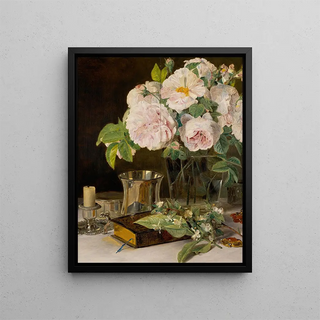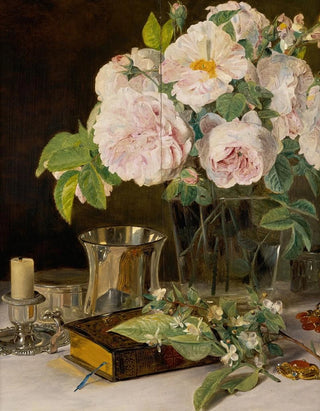Art print | Still life of roses in a glass with roses, a candelabrum, and a silver bowl - Ferdinand Georg Waldmüller


View from behind

Frame (optional)
In the fascinating world of still life, the work of Ferdinand Georg Waldmüller stands out for its ability to capture the ephemeral essence of floral beauty. The art print of his "Nature morte de roses dans un verre avec des roses, un chandelier et une coupe en argent" immerses us in a universe where every detail is carefully observed, every color meticulously chosen. This piece, a true ode to nature, invites us to contemplate the sublime through the apparent simplicity of everyday objects. The roses, symbols of passion and delicacy, bloom inside a glass, while a chandelier and a silver bowl add a touch of refinement to this composition. Waldmüller, with his keen eye, offers us a window into a suspended moment, an invitation to appreciate the fleeting beauty of flowers and the light dancing on surfaces.
Style and uniqueness of the work
Waldmüller's style is characterized by meticulous attention to detail and exceptional mastery of light. In this still life, the roses come alive thanks to precise brushstrokes that reveal the delicate texture of the petals. The shades of pink, white, and green blend harmoniously, creating a visual balance that draws the eye. The choice of objects – the glass, the chandelier, and the bowl – is not accidental. Each element contributes to the atmosphere of the scene, evoking a warm intimacy. The soft, enveloping light highlights the contours of the roses while creating subtle shadows that add depth to the composition. Waldmüller manages to transform ordinary objects into a celebration of life, where each rose tells a story, and every reflection in the glass reminds us of the fleeting beauty of the present moment.
The artist and his influence
Ferdinand Georg Waldmüller, an emblematic figure of Austrian Romanticism, knew how to leave his mark on his era through his unique approach to painting. Born in 1793 in Vienna, he was influenced by the artistic movements of his time, while developing a personal style that combines realism and sensitivity. Waldmüller was able to capture

Matte finish

View from behind

Frame (optional)
In the fascinating world of still life, the work of Ferdinand Georg Waldmüller stands out for its ability to capture the ephemeral essence of floral beauty. The art print of his "Nature morte de roses dans un verre avec des roses, un chandelier et une coupe en argent" immerses us in a universe where every detail is carefully observed, every color meticulously chosen. This piece, a true ode to nature, invites us to contemplate the sublime through the apparent simplicity of everyday objects. The roses, symbols of passion and delicacy, bloom inside a glass, while a chandelier and a silver bowl add a touch of refinement to this composition. Waldmüller, with his keen eye, offers us a window into a suspended moment, an invitation to appreciate the fleeting beauty of flowers and the light dancing on surfaces.
Style and uniqueness of the work
Waldmüller's style is characterized by meticulous attention to detail and exceptional mastery of light. In this still life, the roses come alive thanks to precise brushstrokes that reveal the delicate texture of the petals. The shades of pink, white, and green blend harmoniously, creating a visual balance that draws the eye. The choice of objects – the glass, the chandelier, and the bowl – is not accidental. Each element contributes to the atmosphere of the scene, evoking a warm intimacy. The soft, enveloping light highlights the contours of the roses while creating subtle shadows that add depth to the composition. Waldmüller manages to transform ordinary objects into a celebration of life, where each rose tells a story, and every reflection in the glass reminds us of the fleeting beauty of the present moment.
The artist and his influence
Ferdinand Georg Waldmüller, an emblematic figure of Austrian Romanticism, knew how to leave his mark on his era through his unique approach to painting. Born in 1793 in Vienna, he was influenced by the artistic movements of his time, while developing a personal style that combines realism and sensitivity. Waldmüller was able to capture






